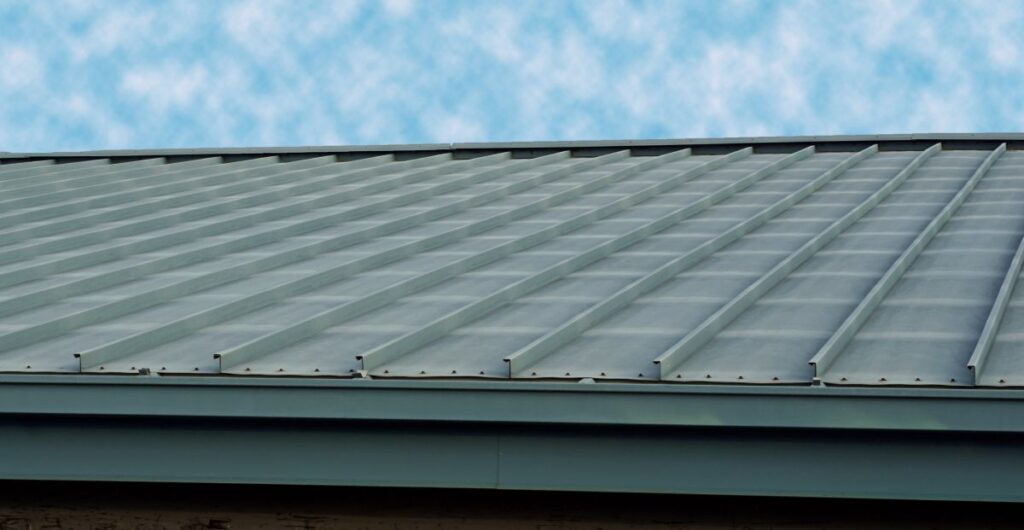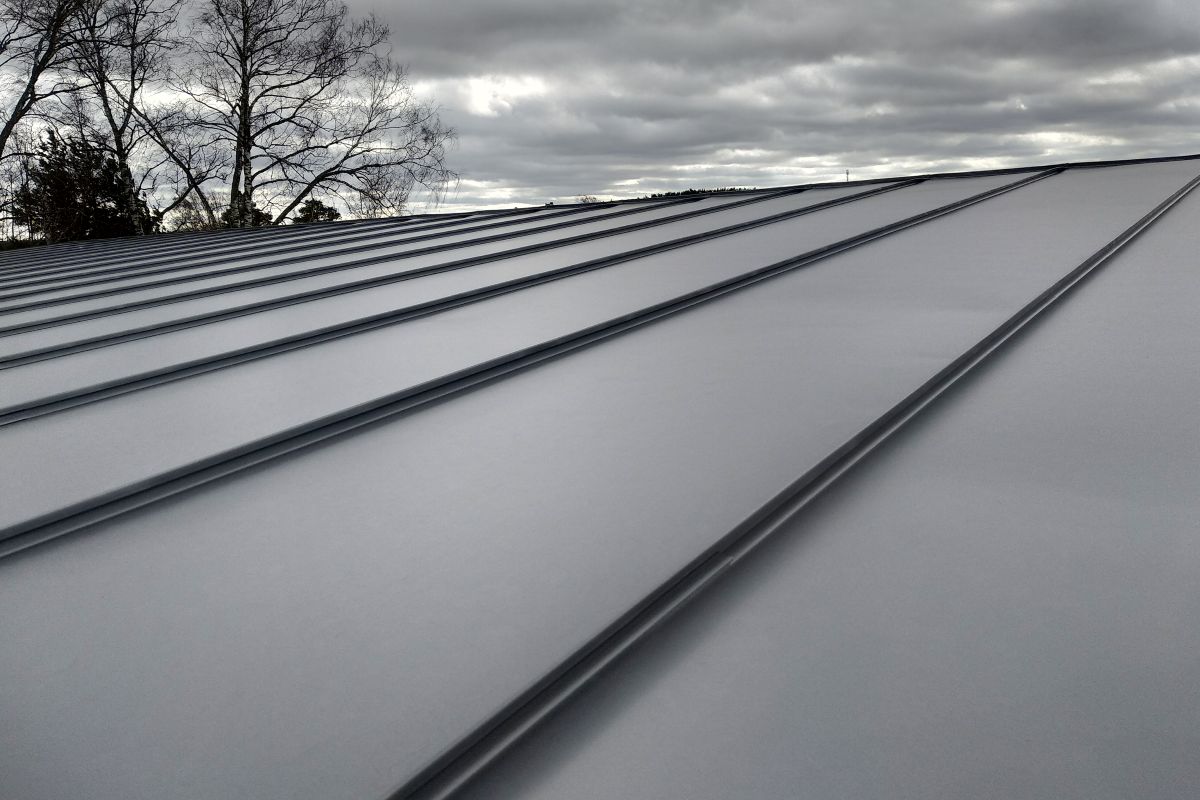Table of Contents
- Introduction: Why Choose Standing Seam Metal Roofing
- What Is a Standing Seam Metal Roof?
- Key Applications of Standing Seam Metal Roofing
- Benefits of Standing Seam Systems for Exterior Restoration
- Material & Design Considerations for Standing Seam Roofs
- Installation Best Practices & What to Look For
- Maintenance, Lifespan & Cost Considerations
- Case Studies & Real-World Applications
- Frequently Asked Questions
- Conclusion & Call to Action
1. Introduction: Why Choose Standing Seam Metal Roofing
When it comes to high-performance, high-durability roof systems, a standing seam metal roof stands out. Total Exteriors specializes in full exterior remediation and replacement after hail, wind, or storm damage, this roofing type is especially relevant. Whether working on residential homes or commercial buildings, using standing seam metal panels helps restore the building envelope with long-term value. In this article we’ll cover the wide range of standing seam metal roof applications, how this system fits into an exterior restoration strategy, and why it’s a smart investment for property owners.
2. What Is a Standing Seam Metal Roof?
A standing seam metal roof is a concealed-fastener roofing system composed of vertically-oriented metal panels whose seams (the raised edges between panels) lock or seam together, creating a continuous surface. Because the fasteners are hidden beneath the panel seams, the roof has fewer exposed penetrations and is more resistant to weather, wind, and moisture infiltration compared to exposed-fastener metal roof systems. These features make standing seam systems particularly well suited for exterior restoration projects where longevity, resilience, and minimal maintenance are important.
3. Key Applications of Standing Seam Metal Roofing
Standing seam metal roofing is versatile and can be applied in many contexts. Below are key applications, especially relevant for exterior renovation and restoration projects.
3.1 Residential Roof Replacement & Upgrades
For homeowners whose roofs have been compromised by hail, wind or storm damage, replacing with a standing seam metal roof provides a major upgrade. The clean lines, hidden fasteners and broad range of finishes make it an attractive choice for both aesthetic and performance reasons.
Switching from shingles or older metal systems to standing seam can significantly improve durability, reduce maintenance and increase property value.
3.2 Commercial Buildings (Warehouses, Office, Retail)
Large-scale commercial properties benefit from standing seam systems because they can span wide roof surfaces, handle harsh weather and provide long service lives with minimal interruption. For a contractor specializing in full exterior remediation, applying standing seam metal roofing across a commercial roof aligns with restoring the building envelope fully.
3.3 Institutional & Community Facilities
Schools, community centres, municipal buildings, and other institutional facilities often require roofing systems that offer durability, low maintenance and aesthetic appeal. Standing seam systems meet these needs and are increasingly used in renovation and new-construction applications.
3.4 Agricultural & Specialty Buildings
Even barns, equipment sheds, and other outbuildings can use standing seam metal panels to get a long-lasting, weather-resistant roof. Some manufacturers explicitly list agricultural structures as an application for standing seam.
3.5 Retrofit & Low-Slope or Architectural Applications
Because standing seam systems can be configured with mechanical seaming, snap locks or specialty profiles, they can be used in retrofit work, architectural accents (dormers, canopies, cornices) and in some low slope situations.
4. Benefits of Standing Seam Systems for Exterior Restoration

When undertaking exterior restoration—especially after storm, hail or wind damage—the advantages of standing seam metal roofing become especially relevant. Here’s how:
4.1 Weather Tightness & Leak Resistance
Because the seams are raised and the fasteners hidden, the roof has fewer penetration points and fewer exposed elements that degrade or leak. This leads to superior weather resistance and fewer failure points.
4.2 Durability & Longevity
Standing seam systems tend to outlast many traditional materials. Some manufacturers claim 40-70+ years with proper installation and maintenance. In restoration work, installing a roof that you may not have to replace again in decades is a compelling value proposition.
4.3 Low Maintenance Requirements
With fewer exposed fasteners and more robust metal panels, maintenance is significantly reduced. The roof surface can remain intact for years with periodic inspections rather than ongoing repairs.
4.4 Energy Efficiency & Sustainability
Many standing seam systems have reflective coatings, high recycled content and are fully recyclable at end of life. This aligns well with modern exterior restoration efforts that value sustainability.
4.5 Aesthetic Appeal & Architectural Value
Standing seam panels offer sleek, modern lines, a variety of colours and finishes, and an upgraded look compared to standard roofing. This can enhance curb appeal and value for both residential and commercial properties.
4.6 Suitable for Harsh Weather, Hail & Wind
In regions exposed to hail, wind and storm risk, the robustness of standing seam metal systems provides significant advantages. The concealed fasteners and strong panel connections reduce the risk of uplift or panel failure under wind loads.
5. Material & Design Considerations for Standing Seam Roofs
Choosing the right design and materials is critical to maximize the benefits of a standing seam metal roof. Here are key factors to consider in a restoration context:
- Panel profile & seam height: Common seam heights are 1″ to 2″, with variations depending on manufacturer and wind/uplift ratings.
- Material gauge & metal type: Steel, aluminum, copper and other alloys are available; gauge (thickness) affects durability, hail resistance and cost.
- Fastening system: Hidden clips or floating clips allow expansion/contraction, reduce stresses, and protect fasteners from weather.
- Coatings & finish: Choose high-quality paint systems (e.g., Kynar®) or reflective coatings for enhanced longevity and energy performance.
- Substructure & insulation: Integration with the building’s envelope matters—over proper decking, vapour barrier, insulation and underlayment to meet energy and structural requirements.
- Snow and ice management: Especially for regions with snow load, appropriate snow guards, gutter systems or design features help manage sliding snow and ice buildup.
- Slope and drainage: While standing seam is suited to many slopes, make sure the roof pitch, runoff, drainage and flashing details meet code and performance expectations. Some profiles suit low slope situations.
6. Installation Best Practices & What to Look For
A standing seam metal roof’s performance is only as good as its installation. For property owners considering this application (especially in a restoration project), here are best practices and key things to verify.
- Choose a contractor experienced in standing seam systems, not just general roofing. The clip installation, seam locking and flashing detail require specialist skill.
- Ensure the substructure is solid, level and prepared. Old or damaged decking, underlying moisture issues or structural weaknesses should be addressed prior to panel installation.
- Confirm that clips are properly installed and allow for metal expansion/contraction without stress.
- Flashing details: roof edges, ridges, valleys, penetrations (vents, skylights, chimneys) must be sealed and integrated with the metal panel system—especially crucial in restoration after storm damage.
- Overlap and seam heights must meet manufacturer specifications and local building codes (especially for wind or snow zones).
- Ensure proper underlayment, vapour barriers, insulation and substrate are in place before panels. For restoration jobs, additional inspection for hidden damage (rot, mold) is wise.
- After installation, inspect panels for alignment, fasteners (hidden), and coatings. Conduct visual inspections and water test if needed. Some manufacturers recommend quality control inspections.
- Review warranty coverage—both for materials and workmanship. Given the long lifespan of standing seam systems, ensure your contractor stands behind their installation.
7. Maintenance, Lifespan & Cost Considerations
Lifespan
With proper installation and maintenance, standing seam metal roofs can last 40-70 years or more.
This makes them especially appealing for restoration projects where longevity and durability are critical.
Maintenance Needs
Compared to traditional roofing systems, maintenance is minimal:
- Periodic visual inspections (twice a year or post-storm)
- Clean gutters and remove debris from roof surfaces
- Check for loose flashings or damaged finish coatings
- Touch up scratched areas to prevent corrosion
Cost Considerations
- Upfront cost is higher than standard metal panels with exposed fasteners or asphalt shingles.
- However, lifecycle cost is lower because of reduced maintenance and longer usage.
- In a restoration context, integrating standing seam roofing may help avoid future replacements and associated disruption.
- Material quality, gauge, finish, and complexity (roof shape, roof penetrations) will all affect cost.
Return on Investment
- Enhanced durability and longevity reduce future replacement risk.
- Lower maintenance and better weather resistance reduce unexpected repair costs.
- Improved aesthetics, higher property value and possible insurance benefits (in some jurisdictions) increase ROI.
8. Case Studies & Real-World Applications
Here are a few illustrative applications, relevant to exterior restoration:
- A commercial building whose traditional roof was repeatedly failing due to hail and wind; conversion to standing seam metal panels eliminated leak risk and resolved maintenance issues.
- A residential home in a high-wind area replacing a shingle roof after storm damage; choosing standing seam metal gave both style upgrade and structural resilience.
- An institutional facility (e.g., community centre) undergoing exterior envelope remediation that included roofing, siding and cladding—all tied together with a standing seam roof installation to provide a long-term solution.
These kinds of projects reflect how standing seam metal roofing can be a major component of a full-exterior restoration strategy—delivering toughness, appearance and longevity.
9. Frequently Asked Questions

Q1: Is standing seam metal roofing worth the extra cost?
A: If you are looking for long-term durability, low maintenance, superior weather performance and a high-quality aesthetic, yes. The higher upfront cost is often justified in restoration contexts.
Q2: Can standing seam be used on low-slope roofs?
A: Yes—many systems accommodate lower slopes when designed properly. Consult manufacturer specifications and ensure proper clips/seams for low slope.
Q3: How does standing seam perform in hail or severe weather?
A: Very well. The continuous panels, hidden fasteners, and robust metal construction give strong resistance to impact, wind uplift and weather intrusion.
Q4: What maintenance is required?
A: Routine visual inspection, cleaning of gutters/debris, checking flashings and touch-ups of coatings if scratched. Far less frequent than many alternative roof systems.
Q5: Can solar panels be installed on standing seam roofs?
A: Yes—many standing seam roofs work very well with solar installations because the clamps can attach to raised seams without penetrating the roof surface.
Q6: How long will a standing seam roof last?
A: 40 to 70 years (or more) is typical when installed properly, which is significantly longer than many shingle or exposed-fastener metal roofs.
Q7: What should I check when selecting a contractor?
A: Experience with standing seam systems, proper clips and seaming tools, good references, detailed quote including underlayment/substructure inspection, warranty coverage.
10. Conclusion & Call to Action
For property owners—residential or commercial—who are focused on restoring their building’s exterior with a roof system that will last decades, a standing seam metal roof is an outstanding option. It aligns perfectly with the goals of full-exterior restoration: durability, performance, minimal maintenance and architectural appeal.
At Total Exteriors Ltd., we specialize in comprehensive exterior remediation and replacement—including roofs, siding, soffits, eavestroughs and cladding. If you’re considering upgrading your roof with a standing seam metal system, we’re ready to help from inspection and material selection, through to expert installation.
Contact us today for a free assessment and learn how a standing seam metal roof can become a core component of your next exterior restoration project.

